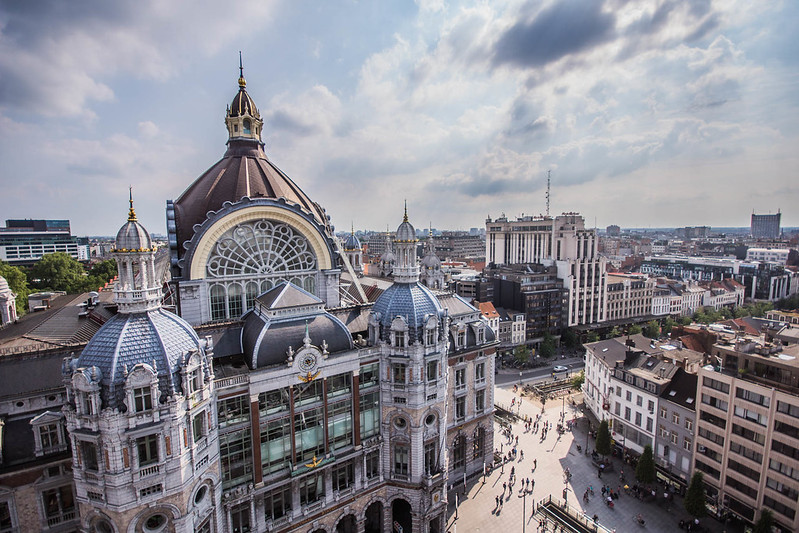If you’re visiting Belgium and are on a tight schedule, you may only have time to stay in either Bruges or Antwerp. Which of these two cities should you choose? In this post, I compare the two on several key aspects including overall vibe, sights and culture, food and nightlife.
Both Antwerp and Bruges are in the Dutch-speaking Flanders region of Belgium and are really close and well-connected to each other (30+minute train ride). Both cities have a rich history and a unique appeal. Antwerp and Bruges, however, are of very different sizes as Bruges’ population is less than 150.000 while Antwerp is over 3 times larger.
Table of Contents
Bruges or Antwerp: what travelers say
- Bruges is a charming well-preserved old small town, albeit overrun with tourists. Its main attractions are its picturesque canals, cobbled streets, and medieval buildings.
- Antwerp is a larger port city with great architecture of different periods (medieval, early 20th, and modern), excellent museums, a historic medieval center, and a long riverfront. It’s also a major shopping center in Belgium, and has lots of bar and restaurant options.
- If you like a bigger city feel and more animation, and don’t mind a more gritty atmosphere, construction work, and some less attractive areas, you may enjoy a night or two in Antwerp, taking a day trip to Bruges.
- If, on the other hand, you prefer to stroll around a calm, walkable, and picture-perfect medieval decor for a day or two, and don’t mind the hoards of tourists, Bruges may be a better basecamp.

Bruges or Antwerp: access & transportation
Antwerp is the first Belgian city you reach when coming from the Netherland, e.g. from the Hague (about 1 hour) or Rotterdam (about 1h30 taking only slower inter-city trains).
It takes about 3 to 4 hours to get from The Hague to Bruges depending on whether you take high-speed (costlier) Thalys trains or all inter-city. Amsterdam to Bruges by Thalys takes about 3.5 hours and you need to change to an inter-city train in Antwerp – doing the whole thing by inter-city trains may take an additional hour.
It’s also easy to get from Antwerp to Brussels by train to catch a flight to another European city or the Eurostar train to London. Check out the Belgium train route planner site here.
Flanders mostly has busy roads and urban zones, not so much attractive countryside, so driving to and within Belgian cities is mainly a hassle. Traveling by train is much easier, and you easily get around larger cities like Antwerp using the efficient tram and bus network – Bruge is small enough to walk everywhere.
If you have to drive, however, Bruges is an easier choice than Antwerp since you can park at the train station’s car park for a few euros a day. The parking ticket includes round-trip fares to the center for 4 people. Thus you can take the number 12 bus to Markt (old town) if you don’t feel like doing the 15-minute walk.
Bruges or Antwerp: vibe & people

Burges and Antwerp have completely different looks and feel. As mentioned, Antwerp is a much bigger city and feels like one, while Bruges has a small-town vibe. Bruges can be described as picturesque, compact, and touristy with a beautifully preserved historic center and attractive canals. It’s not very vibrant but pleasant to visit for a day or two.
Antwerp has a larger population so unlike Bruges, you’ll likely see many more locals than tourists. Antwerp is a mercantile city where business is first. There is also often construction work all over the city including major roads, city blocks, underground parking garages, etc, often disrupting traffic and public transport.
Both cities, however, will give you a taste of Flanders and Belgium, historical and scenic buildings/architecture, and museums. Bruges’ historic city center is compact and can easily be visited in one day.
Bruges or Antwerp: sights & culture

Bruges is a picture-perfect version of an old Flemish town. All the buildings in the historic city center are from the same period. Antwerp, on the other hand, is a mix of the historic city center, the Zurenborg Art Nouveau neighborhood, and the 21st-century landmark buildings.
Besides the old town, Antwerp has great architecture, like Cogels-Osylei street which is filled with Art Nouveau turn-of-the-century façades. Antwerp also has Middleheim, one of Europe’s greatest statue parks, the old warehouses lining the old port, excellent museums, and an Amsterdam-style red-light district North of the old town.

The city also has a long waterfront on the Scheldt river (vs Bruges’ canals). The Bercham station is one of the most glorious Beaux Arts train stations in Europe. The cathedral, the Plantin and Moretus museum, the house of Rubens are among the popular sights in Antwerp.
In Bruges, you can walk around the museum-like medieval town. Most visitors find Burges very romantic with its white wooden bridges and ancient Flemish warehouse façades from the era when Bruges was one of the richest cities and largest ports in the world.
You can visit Bruges’ chocolate museum, the Zot Brewery (and have a taste of unrefined beer), go to chocolate shops. You can admire the canals full of swans and the city center, including the Burg square with its stunning 14th-century Stadhuis (city hall) and the Markt square with its 13th-century belfry and 83m tower with breathtaking views.
Both Bruges and Antwerp have great free walking tours you can join.
Bruges or Antwerp: food & nightlife

If nightlife is important to you, Antwerp is probably a better choice than Bruges. Bruges is charming but relatively quiet at night. Antwerp on the other hand, has a good reputation for night fun, being an animated port city.
In Antwerp, there are plenty of nice restaurants, cafés, and quirky pubs in the historic center. Besides the old town, the ‘T Zuid area, located South of the center, is another and trendier (hence expensive) area for bars and restaurants.
An example of an excellent restaurant overlooking the harbor is the Zuiderterras. The Grand Café Leroy in ‘t Zuid offers a really nice garden. You can also have a drink while listening to a DJ at café King Kong on the Volkstraat avenue.
In Bruges, you can do the brewery tour at Brouwerij De Halve Maan, have a drink at De Kelk, and have dinner at Oud Handbogenhof or Pieter Pourbus.
Obviously, chocolate, fries, waffles, and world-class Belgian beer (Duvel, Hoogarten) are tasty local specialties you can enjoy in both Bruges and Antwerp. In Bruges, these things can be generally be bought cheaper away from the main tourist stretch.
Bruges or Antwerp: shopping

Antwerp has excellent central shopping and is often considered to have the best shopping in Belgium. The shopping areas in Antwerp primarily cater to locals rather not tourists, which makes it attractive to visitors.
The main shopping areas in Antwerp include the historic city center, the Meir area, Quartier Latin, Wilde Zee, the Fashion District, Het Zuid, and the Station District.
Bruges or Antwerp: lodging

Travelers who have stayed in different hotels often praise the Ibis Budget close to Antwerp’s central station. Not a luxury hotel, but it’s clean, modern and has free wifi. It’s only a short tram ride or 15-20 minute walk from the city center and Grote Markt. It’s a convenient location when coming from Paris or Amsterdam or for a day trip to Gent or Bruges.
Besides the Ibis, there are many more hotels of different categories around the Antwerp central station. These are conveniently located, allowing you to quickly drop your luggage and walk to the city center for a day visit.
Travelers also recommend the Ibis Budget in Bruges – some even prefer it to more expensive canalside hotels they’ve stayed in in the town center.
Hotels in Antwerp generally have much better value for the money compared to Bruges due to the latter being highly touristy. Also be aware that August is peak season in Bruges though not so much in Antwerp which is a mixed tourist and business destination.
Bruges or Antwerp: day trips
From either Bruges or Antwerp, you can easily take a day trip to the other or to Ghent, the third city of this small triangle area of Flandres – see this other post for an in-depth comparison of Antwerp and Ghent.
All three cities are connected by 1 or 2 hourly trains with quick rides under one hour between them. So you can just hop on a train to Antwerp as soon as you’re done seeing Bruges for example (no reservation needed), or vice-versa.
If you like canals, you can check out Lier, another nice little town close to Antwerp, which is known as “little Bruges” (see this site for more information). From Bruges, you can also go up the coast using the commuter tram and see the towns and the German Atlantik Wall.
***
Photo credits:
(1) Featured: “Antwerp train station” (CC BY 2.0) by MatthieuBout
(2) “Bruges” (CC BY-SA 2.0) by photoverulam
(3) “IMG_5073” (CC BY-SA 2.0) by Twang_Dunga
(4) “Bruges” (CC BY 2.0) by interbeat
(5) “Entering the castle” (CC BY 2.0) by Pedro Nuno Caetano
(6) “Antwerp bourla theater” (CC BY 2.0) by MatthieuBout
(7) “Gilded shopping center in Antwerp” (CC BY 2.0) by Falling Outside The Normal Moral Constraints
(8) “Antwerp street” (CC BY 2.0) by grace_a




